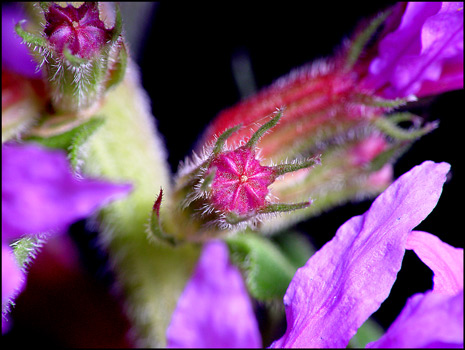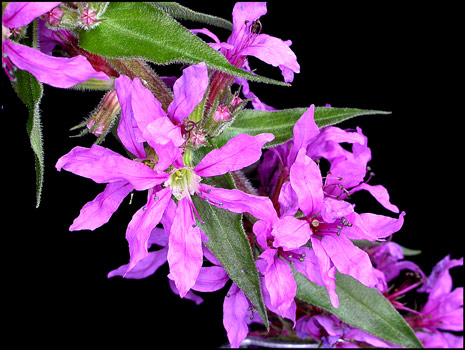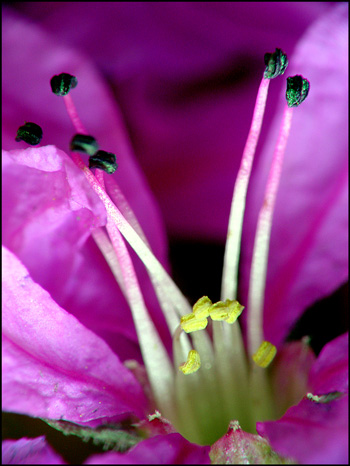|
|
A Close-up View of the Beautiful Invader "Purple Loosestrife" (Lythrum salicaria) by Brian Johnston (Canada) |
|
|
A Close-up View of the Beautiful Invader "Purple Loosestrife" (Lythrum salicaria) by Brian Johnston (Canada) |
At the beginning of the 1800's, settlers to North America brought purple loosestrife plants from Europe to display in their gardens for their showy magenta blooms. The ships that carried them used soil containing loosestrife seeds as ballast in their holds. Once present, the plant spread rapidly beside roads and drainage ditches. Because of its beautiful flower-heads, the plant was actually sold as an ornamental. Unfortunately, it was not immediately apparent that North America had no effective predators for this fast growing plant. Soon, purple loosestrife began displacing the native plants which supplied a food source for many birds and other animals. In addition, loosestrife didn't provide as effective a ground cover as many of the plants that it replaced. Animals, therefore, were forced to move to other areas unaffected by the alien takeover. More recently, the plant has begun to invade drier sites as well as wetlands, and thus is becoming even more of a problem. Research is being done on the possibility of introducing European insect predators in order to control the growing invasion.
The image above shows a typical flower with six petals. Plants may have flowers with from five to seven petals, but all flowers on a particular plant have the same number. Loosestrife petals have a wrinkled appearance. Interestingly, the number of stamens (the male pollen-bearing organ) is always double the number of petals. (More about this later.)
Purple loosestrife plants are from one to two metres in height, with from one to fifty stems. The photograph below shows how the flowers are arranged in spikes (called racemes) which range from ten to thirty centimetres in length.

The following image shows one raceme. Notice how the flowers completely encircle the spike as they bloom in order from bottom to top.

A close-up of a stem reveals the lance-shaped leaves and the covering of very fine white hairs. Plants growing in shady conditions tend to have less hair than those growing in the open. The stem may be green (as in the first image in the article), or purple, as in the image below. The cross-section of the stem is almost round, but tends to have from four to six sides.

Below is an image showing a group of buds about to bloom. Notice the sepals (modified flower leaves) which curve up around the purple unopened buds. Since there are five sepals surrounding each bud, the flowers that eventually bloom will have five petals.

Here is a front view of one bud. Careful observation will reveal that this image is not of the same plant as the previous one! The six sepals in this example will result in a flower with six petals (like the one in the first image in the article).

On any section of spike, there are blooms in all stages, from unopened bud to full flower. Notice the tight packing of leaves, buds and flowers on the stem.

Purple loosestrife flowers are unusual in that they are 'trimorphic'. Three kinds of flowers are observed, where the differences are in the relative lengths of (stigma-style) and (anther-filament) combinations. All of the flowers on a particular plant are of the same type. Notice that in the flower below, there is a pale yellow spherical stigma at the exact centre. Below this there are black anthers on red filaments. Above the stigma are bright yellow anthers.

A magnified side view shows the situation more clearly. There are six black anthers on long pinkish filaments, and six yellow anthers on white filaments. (The stigma and style have been removed.) As mentioned earlier, all purple loosestrife flowers have a total of twice as many stamens as they have petals.

Now consider the side view below. Notice the relative lengths of the stigma and the two kinds of stamens. This is called the 'medium-styled form' since it has short and long stamens.


Two other forms exist: the 'short-styled form', with medium and long stamens, and the 'long-styled form', with short and medium stamens. This last form can be seen in the third image of the article which shows a single spike of flowers. Notice that each flower has a very long stigma-style that projects out a considerable distance.
Under the microscope, dark-ground illumination reveals the details of one of the darker anthers and its filament.

The image below shows both anther types. The darker anther is covered with pollen grains.

Under a higher magnification, light green pollen grains cover the surface of the anther. The pollen appears to have an ellipsoidal shape. (The colour and size of the pollen depends on which of the three forms is exhibited. Next summer I hope to study and document the differences for a future article.)


As time passes, flowers near the base of the spike begin to die, and the petals fall off. It is clear from the following image that this plant is the 'long-styled form' with short and medium stamens. The very long projecting stigma and style can be seen, both in the dead blooms at the bottom, and the bloom at the middle right.

I was completely unaware that one flower contained a visitor while taking the macrophotographs in the article. Only when I had dissected a bloom and had an anther under the microscope, did its movement attract attention.

It is indeed unfortunate that this colourful wildflower has such a devastating effect on the environment. Based upon the pervasiveness of this plant in the southern Ontario landscape, efforts to control its spread seem to have proved ineffectual. Until better control has been achieved, we should try to appreciate its beauty while regretting the destruction caused by this 'noxious weed'.
Photographic Equipment
The low magnification photographs in the article were taken using a Nikon Coolpix 4500 with natural light and the Nikon Cool light SL-1. Higher magnification images were taken using a Sony CyberShot DSC-F 717 equipped with an accessory achromat which screws into the 58 mm filter threads of the camera lens. (This produces a magnification of from 7X to 9X for a 4x6 inch image.) Still higher magnifications were obtained by using a macro coupler (which has two male threads) to attach a reversed 50 mm focal length f 1.4 Olympus SLR lens to the F 717. (The magnification here is about 13X for a 4x6 inch image.) The photomicrographs were taken with a Leitz SM-Pol microscope (using a dark ground condenser), and the Coolpix 4500.
All comments to the author Brian Johnston are welcomed.
Published in the November 2004
edition of Micscape.
Please report any
Web problems or offer general comments to the
Micscape
Editor.
Micscape is the on-line
monthly magazine of the Microscopy UK web
site at
Microscopy-UK
© Onview.net Ltd, Microscopy-UK, and all contributors 1995 onwards. All rights reserved. Main site is at www.microscopy-uk.org.uk with full mirror at www.microscopy-uk.net .